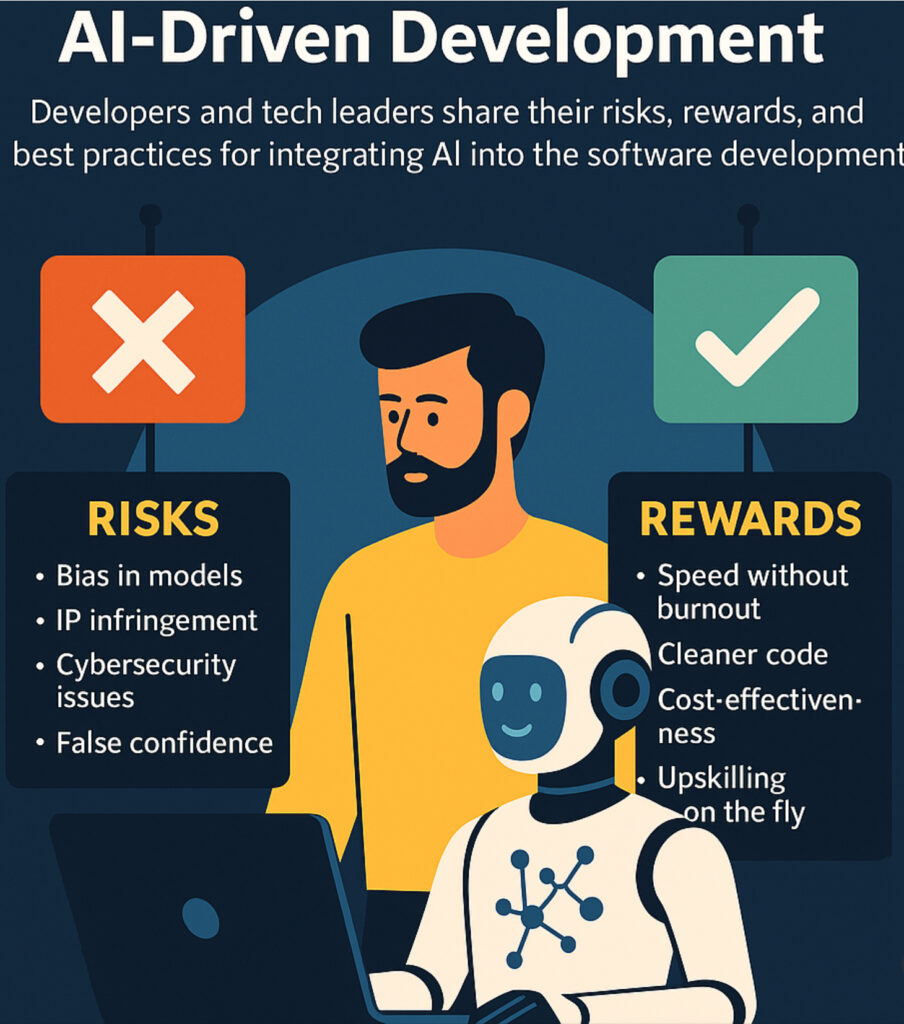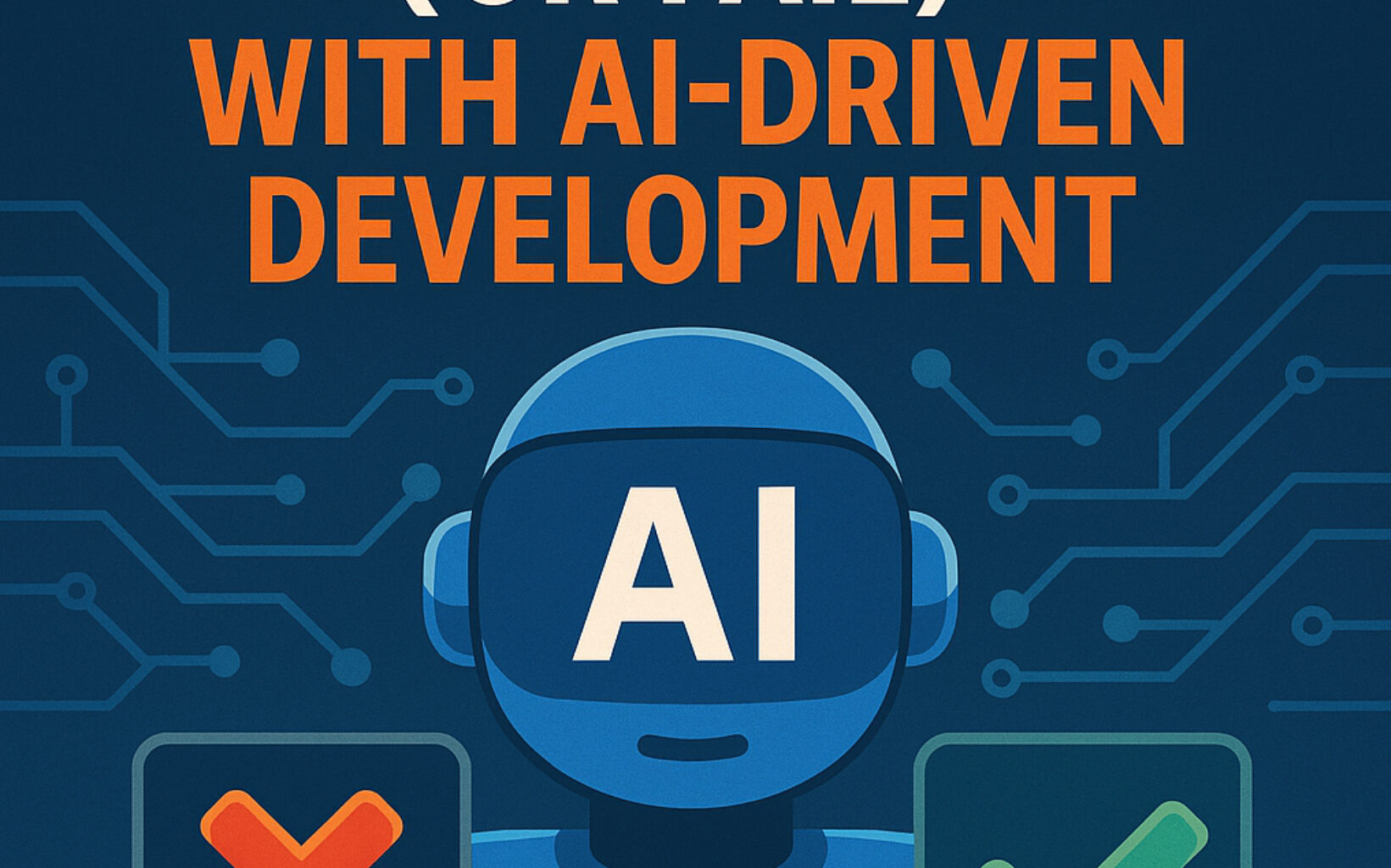Developers and tech leaders share their risks, rewards, and hard‑won best practices for weaving generative AI into every stage of the software‑development lifecycle.
Why AI‑Augmented Development Matters — Now
Market intelligence firm QKS Group projects the global AI‑augmented software‑development market will grow 33 % CAGR through 2030.¹ Enterprises in finance, healthcare, retail, telecom, and manufacturing already embed generative‑AI tooling—from code assistants to self‑healing test suites—into design, build, test, and deploy workflows to ship faster and with higher quality.
Yet the same acceleration can magnify risk. Interviews with engineers, product leaders, researchers, and attorneys highlight four recurrent failure modes and four durable benefits.
Four Primary Risks
| Risk | What Can Go Wrong | Real‑World Insight |
| Bias in training data | Models replicate social, linguistic, or cultural prejudice, leading to exclusionary features or faulty analytics. | Most Loved Workplace had to “re‑label everything with human‑in‑the‑loop gaming” after its sentiment model mis‑read multicultural tone, says founder Louis Carter. |
| Intellectual‑property leakage | Models trained on copyrighted corpora may emit infringing code or text, triggering litigation or forced rewrites. | Ongoing suits against OpenAI and Meta show the stakes. “Code is copyrightable; outputs can infringe,” warns Kirk Sigmon of Banner & Witcoff. |
| Cybersecurity vulnerabilities | Autogenerated code may embed SQL‑injection flaws, secrets, or unsafe dependencies. | Privacy attorney Maryam Meseha recounts firms that “shipped features with embedded security flaws because the code looked right.” |
| False confidence & technical debt | Teams over‑trust model output, promoting unexplainable code to production. | “If you can’t explain it, don’t ship it,” Carter now tells devs after a generative fix passed unit tests but failed under real traffic. |
Four Tangible Rewards
| Reward | Mechanism | Evidence |
| Faster delivery without burnout | Automates boilerplate, stub creation, and test scaffolding so humans focus on logic. | A junior engineer cut a half‑day rules‑engine task to one hour using Claude, boosting morale. |
| Cleaner code, fewer bugs | Continuous AI static analysis, linting, and auto‑tests surface issues early. | Most Loved Workplace pairs Claude refactors with Sentry monitoring for early defect capture. |
| Cost‑effectiveness | Efficiency lets teams do more with fewer head‑count hours, especially in maintenance. | Brown University’s Ja‑Naé Duane sees up to 35 % faster release cycles when Copilot‑like tools suggest fixes in real time. |
| On‑the‑job up‑skilling | Contextual suggestions teach patterns; low‑code platforms widen participation. | Carter observes juniors “thinking like senior engineers” sooner; Duane notes Bubble and Zapier enabling non‑developers to ship apps. |
Best‑Practice Playbook for Tech Leaders
- Start with a narrow, auditable pilot
Select one domain (e.g., test generation) where outputs are easy to review. Instrument KPIs before and after to prove value. - Keep humans firmly “in the loop”
Require developers to justify and document any AI‑generated code. Gate merges behind explainability checks. - Build an AI Coding Guardrail Library
Static‑analysis rules, OSS‑license scanners, and prompt‑engineering templates minimize IP and security violations at source. - Mandate diverse, well‑labeled training data
Counter latent bias by supplementing foundation‑model prompts with domain‑specific, demographically balanced examples. - Harden security early
Integrate automated SAST/DAST, secret‑detection, and dependency‑graph scanning into every CI run. Review prompts for data leakage. - Update governance & contracts
• Add model‑output indemnification clauses
• Clarify ownership of code produced with assistants
• Track provenance metadata for every AI contribution. - Invest in continuous skills development
Pair juniors with AI tools plus senior code reviews to accelerate learning without sacrificing craft. - Measure ROI & refactor processes quarterly
Combine velocity metrics (cycle time, lead time) with quality metrics (escaped defects, MTTR) to ensure gains outstrip new risks.

How to Fail (So You Don’t)
| Anti‑Pattern | Early Warning Sign | Preventive Action |
| “Blind copy‑paste” culture | Pull requests full of unexplained blobs | Enforce E‑docs: every change needs an Explanation doc string. |
| Security afterthought | Pen‑test finds default admin password in code | Shift‑left security; block secrets at commit hook. |
| One‑size‑fits‑all models | Same LLM used for UI copy and safety‑critical logic | Adopt a model matrix: match task criticality to model tier and validation depth. |
| Neglected junior pipeline | All hiring frozen below staff level | Reserve rotation slots for entry‑level engineers to grow under AI mentorship. |
The Bottom Line
AI‑augmented development is not a silver bullet, nor is it optional. The organizations that thrive will treat generative AI as a co‑engineer—powerful, fallible, and always subject to human judgment. By baking in bias checks, IP hygiene, robust security, and continuous learning loops, teams capture the speed gains without mortgaging their future in hidden debt.
“In an era where speed, innovation, and adaptability define competitive advantage, AI‑augmented development is a transformative force.” — QKS Group, May 2025
Move deliberately, instrument everything, and stay humble: success lies in the balance between bold automation and disciplined oversight.
References
- QKS Group, AI‑Augmented Software Development Market Outlook, May 2025.
- Kickstand Research & Jellyfish, Engineering Burnout Report, 2024.
- InfoWorld, “How to succeed (or fail) with AI‑driven development,” June 2025.









